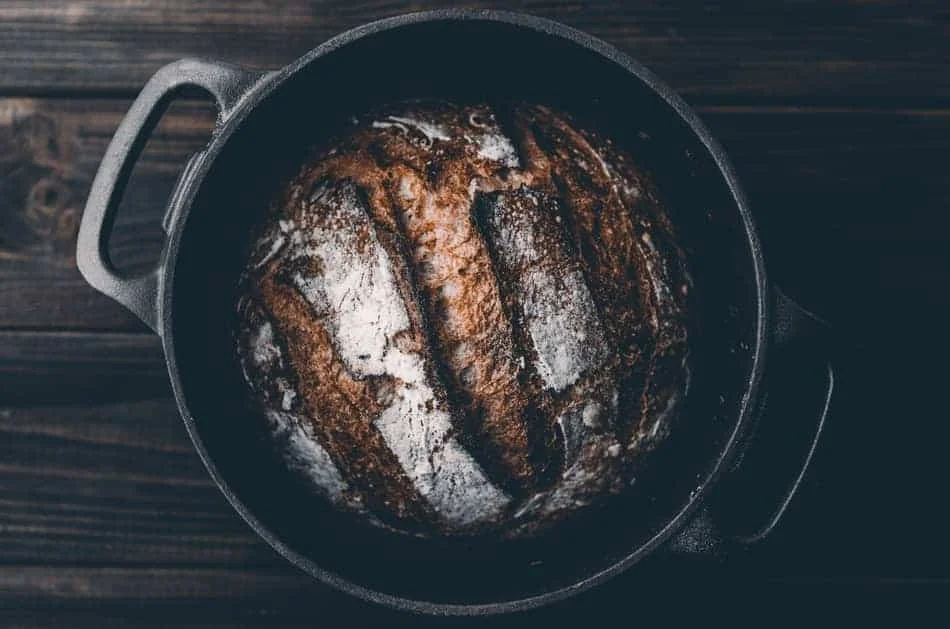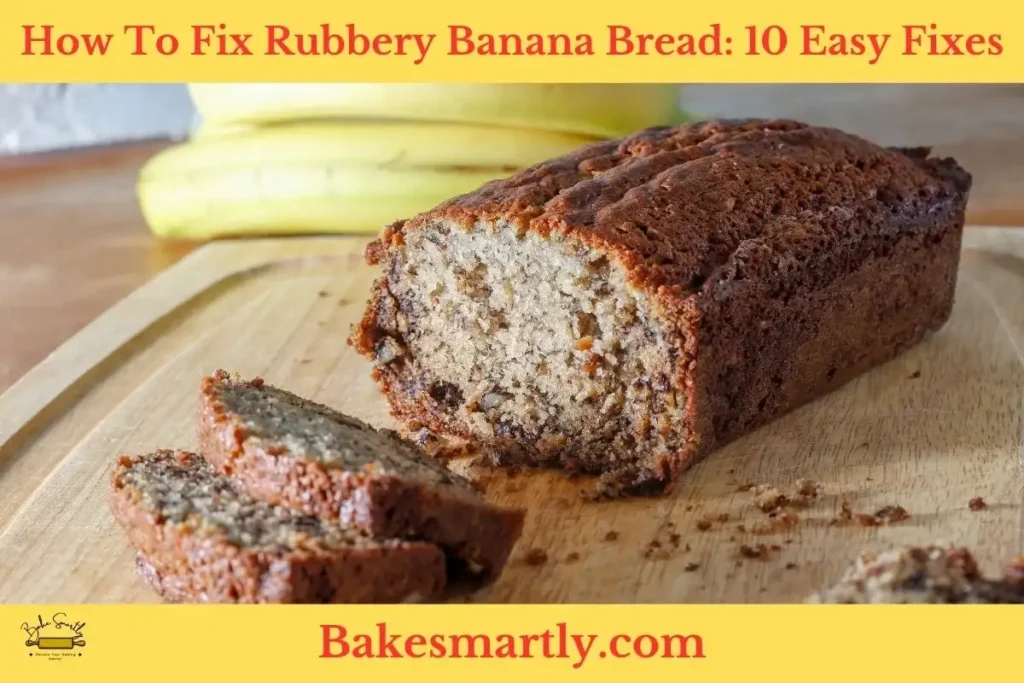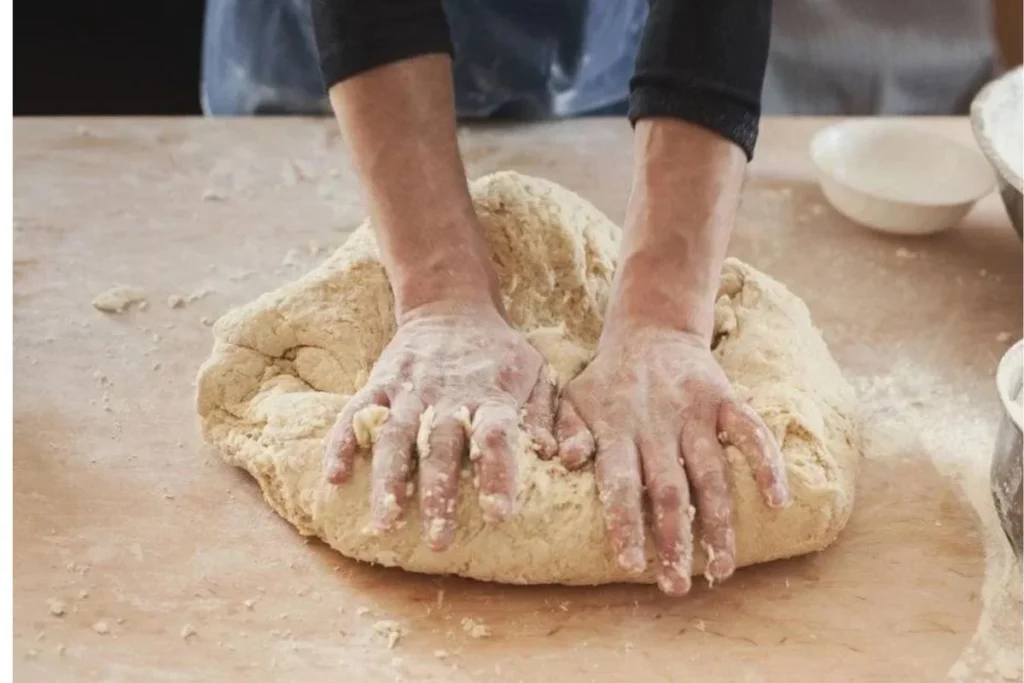
The Easiest Way to Bake Sourdough Bread Without a Dutch Oven
If you’re a bread enthusiast, you’re likely familiar with the wonders of sourdough bread. Traditionally, sourdough bread is baked in a Dutch oven, which helps create the perfect environment for a beautiful loaf to rise and develop its signature characteristics. However, not everyone has a Dutch oven readily available in their kitchen.
Fear not! In this article, we will explore 4 techniques to bake sourdough bread without a Dutch oven, allowing you to enjoy homemade sourdough bread even if you don’t own this specialized baking equipment.
Table of Contents
Toggle4 Alternative baking techniques for sourdough bread without a Dutch oven
These are my 4 best alternative baking techniques for sourdough bread without a Dutch oven.
1. Baking on a Baking Stone or Pizza Stone
Using a baking stone or a pizza stone is one of the easiest ways to recreate the Dutch oven effect without actually using one. Here’s how you can do it:
- Preheat your oven: Place the baking stone on the middle rack of your oven and preheat it to the desired temperature, usually around 450°F (230°C). Preheating the stone ensures that it becomes hot enough to give your bread a crispy crust.
- Shape and proof your dough: After the final rise of your sourdough bread, shape it into a round or oval loaf and let it undergo its final proofing on a piece of parchment paper.
- Score the dough: Just before baking, use a sharp knife or a bread lame to make shallow cuts on the surface of the dough. This helps control the expansion of the loaf during baking.
- Transfer the dough onto the hot baking stone: Carefully slide the parchment paper with the dough onto the preheated baking stone.
- Bake and create steam: Quickly close the oven door to trap the steam and bake the bread for the recommended time, usually between 30 to 40 minutes. To create steam, you can place a small oven-safe dish filled with water at the bottom of the oven or spritz water onto the sides of the oven.
- Enjoy your homemade sourdough bread: Once the bread is golden brown and sounds hollow when tapped on the bottom, remove it from the oven and let it cool on a wire rack before slicing and savoring every bite.
2. Using a Covered Roasting Pan
If you don’t have a baking stone, another method that can yield excellent results is using a covered roasting pan. Follow these steps to bake sourdough bread without a Dutch oven using this method:
- Preheat your oven: Place the covered roasting pan, along with its lid, in the oven and preheat it to the desired temperature, typically 450°F (230°C). Preheating the pan ensures that it becomes hot enough to create a similar baking environment to a Dutch oven.
- Shape and proof your dough: After the final rise of your sourdough bread, shape it into a round or oval loaf and let it undergo its final proofing on a piece of parchment paper.
- Score the dough: Just before baking, use a sharp knife or a bread lame to make shallow cuts on the surface of the dough.
- Transfer the dough into the hot roasting pan: Carefully place the dough, along with the parchment paper, into the preheated roasting pan. Be cautious as the pan and lid will be extremely hot.
- Cover and bake: Put the lid on the roasting pan to create a sealed environment and bake the bread for the recommended time, typically around 30 to 40 minutes.
- Uncover and brown the crust: After the initial baking time, remove the lid from the roasting pan and continue baking for an additional 10 to 15 minutes, or until the crust turns golden brown.
- Cool and indulge: Once baked, remove the bread from the pan and let it cool on a wire rack before slicing. The aroma and taste of your homemade sourdough bread will surely be worth the wait!

3. Using a Covered Casserole Dish
If you don’t have a Dutch oven, another alternative is to use a covered casserole dish. This method can help create a similar baking environment for your sourdough bread. Here’s how you can do it:
- Preheat your oven: Place the covered casserole dish, along with its lid, in the oven and preheat it to the desired temperature, typically 450°F (230°C). It’s important to preheat the dish to ensure even heat distribution.
- Shape and proof your dough: After the final rise of your sourdough bread, shape it into a round or oval loaf and let it undergo its final proofing on a piece of parchment paper.
- Score the dough: Just before baking, make shallow cuts on the surface of the dough using a sharp knife or a bread lame. This helps control the expansion of the loaf during baking.
- Transfer the dough into the hot casserole dish: Carefully place the dough, along with the parchment paper, into the preheated casserole dish. Be cautious as the dish and lid will be hot.
- Cover and bake: Put the lid on the casserole dish to create a sealed environment and bake the bread for the recommended time, usually around 30 to 40 minutes.
- Uncover and brown the crust: After the initial baking time, remove the lid from the casserole dish and continue baking for an additional 10 to 15 minutes, or until the crust turns golden brown.
- Cool and enjoy: Once baked, remove the bread from the dish and let it cool on a wire rack. Slice and savor the delightful flavors of your homemade sourdough bread.
4. Utilizing a Double Pan Method
The double pan method is another effective technique to bake sourdough bread without a Dutch oven. It helps create a steamy environment for optimal crust development. Follow these steps to utilize this method:
- Preheat your oven: Place two identical baking pans in the oven and preheat it to the desired temperature, typically 450°F (230°C). The two pans stacked on top of each other will mimic the effect of a Dutch oven.
- Shape and proof your dough: Shape your sourdough dough into the desired loaf shape and allow it to undergo its final proofing.
- Score the dough: Prior to baking, score the surface of the dough with shallow cuts using a sharp knife or a bread lame.
- Transfer the dough onto the lower pan: Carefully place the shaped dough onto the lower preheated baking pan.
- Add steam: Quickly pour a cup of boiling water into the empty upper pan to create steam. The steam will help develop a crispy crust.
- Bake and rotate: Place the pans with the dough back into the preheated oven and bake for the recommended time. Halfway through baking, rotate the pans to ensure even heat distribution.
- Cool and savor: Once the bread is golden brown and fully baked, remove it from the oven and let it cool on a wire rack. Allow it to cool completely before slicing and enjoying your homemade sourdough bread.

Tips for Successful Sourdough Bread Baking without a Dutch Oven
Baking sourdough bread without a Dutch oven may require some adjustments and techniques to achieve optimal results. Here are some valuable tips to help you succeed in your sourdough bread baking endeavors:
- Preheat your baking surface: Whether you’re using a baking stone, a cast iron skillet, a covered casserole dish, or the double pan method, it’s crucial to preheat the baking surface along with your oven. This ensures that the bread receives immediate heat when placed in the oven, promoting proper rise and crust development.
- Create steam: Steam is essential for achieving a beautiful crust on your sourdough bread. To create steam, you can place a small oven-safe dish filled with water at the bottom of the oven or use a spray bottle to mist water onto the sides of the oven. The steam helps keep the surface of the dough moist during the initial stages of baking, allowing the crust to become crispy.
- Use a baking stone or preheated cast iron skillet: If you’re aiming for a crusty artisan-style sourdough bread, using a baking stone or a preheated cast iron skillet can make a significant difference. These baking surfaces retain and distribute heat evenly, resulting in a crispier crust. Just make sure to preheat them adequately before transferring the dough.
- Experiment with different baking vessels: While a Dutch oven is ideal, don’t be afraid to get creative with other baking vessels. Try using a covered casserole dish, a deep roasting pan with a lid, or even a large stainless steel bowl inverted over the dough. These alternatives can help trap steam and create a favorable baking environment.
- Adjust baking time and temperature: Since each baking vessel and oven behaves differently, it’s essential to keep a close eye on your bread while it bakes. Monitor the color of the crust and tap the bottom of the loaf to check for doneness. If the crust is browning too quickly, you may need to lower the oven temperature or shorten the baking time slightly.
- Incorporate steam during the baking process: In addition to creating steam at the beginning of the bake, you can introduce steam into the oven during the baking process. For example, you can spritz water onto the sides of the oven or use a spray bottle to mist the dough itself. Be cautious when opening the oven to prevent heat loss.
- Allow for proper cooling: After removing the bread from the oven, resist the temptation to slice into it immediately. Allowing the bread to cool completely on a wire rack ensures that the interior finishes setting and the flavors develop fully. This results in a better texture and taste.
- Practice and make adjustments: Baking sourdough bread is both an art and a science. It may take a few attempts to find the perfect technique and timing that work for your specific baking setup. Don’t be discouraged by any initial setbacks—learning from each bake will help you improve and master the process.
Which Method is Better for Beginners?
If you’re new to sourdough bread baking and don’t have a Dutch oven, you might wonder which alternative method is better suited for beginners. While both the covered casserole dish method and the double pan method can yield excellent results, they do have some differences to consider.
The covered casserole dish method is relatively straightforward and beginner-friendly. It closely mimics the baking environment created by a Dutch oven, with the covered dish trapping steam and providing even heat distribution. This method requires preheating the dish, transferring the dough, and covering it before baking. It’s a simple and effective way to achieve a crispy crust and a well-risen loaf.
On the other hand, the double pan method also produces excellent results but requires a bit more attention to detail. With this method, you stack two baking pans on top of each other to create a steamy environment. While it may sound slightly more complex, it offers the advantage of versatility. You can use different combinations of pans to achieve various crust textures and shapes. However, it may take some practice to master the technique of adding steam and achieving the desired crust.
For beginners, the covered casserole dish method is often recommended because of its simplicity and reliable results. It’s a great starting point for understanding the importance of steam and heat distribution in sourdough bread baking. As you gain more experience and confidence, you can explore the double pan method and experiment with different baking vessels to diversify your baking repertoire.
Conclusion
Baking sourdough bread without a Dutch oven is not only possible but also an opportunity to get creative with your baking methods. Whether you choose to use a baking stone, a covered roasting pan, a cast iron skillet, or other alternatives, the key is to create the right baking environment and ensure the bread receives enough heat and steam to develop a crispy crust and a delicious, tangy flavor. With these techniques, you can enjoy the satisfaction of homemade sourdough bread without the need for specialized equipment.
Lindsey Mackenzie
About me
Hi there! I’m Lindsey Mackenzie, the founder of Bake Smartly. Baking has been my passion since childhood, growing up in my father’s bakery. With Bake Smartly, I’m excited to share my love for all things sweet and savory. Join me on this delicious journey as we whip up scrumptious treats and sprinkle joy into every bite!






